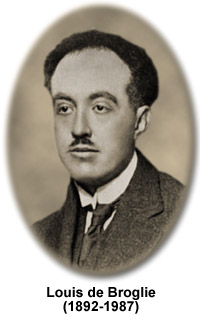Louis de Broglie
(1892-1987)

In the early twentieth century, the long standing argument about whether the character of light was particle-based or wavelike was finally coming to an end as the scientists of the day began to accept that light could assume a dual nature. The possibility that such a duality might apply to matter as well as light was first proposed by physicist Louis de Broglie. Born in Dieppe, France, de Broglie studied in Paris and was descended from members of the French nobility. In his youth, he considered a career as a diplomat, but later turned to science and pursued the study of theoretical physics. His brother, Maurice, who had also decided to become a physicist and made many advances in the study of X-rays, reportedly had a considerable influence on de Broglie and was the first to introduce him to the work of Albert Einstein and Max Planck.
Louis de Broglie received a science degree in 1913, but was soon after required to enter the military. During World War I, he was stationed at the Eiffel Tower as part of the wireless telegraphy army subdivision. When not occupied by official duties, de Broglie filled many of his hours pondering scientific questions, which helped prepare him to continue his studies in 1920 after the war had ended. The focus of his research upon his return to Paris shifted to mathematical physics and his doctoral thesis consisted of research on quantum theory. Within de Broglie’s thesis, which was completed in 1924, many of his most profound ideas were put forth, including his groundbreaking theory of electron waves. He had published some work on electron waves in scientific journals previously as well, but the articles were given little notice. It was not until Einstein read a copy of de Broglie’s thesis that the revolutionary nature of his ideas was understood. Due to Einstein’s attention, other physicists became familiar with de Broglie’s wave theory and utilized it in shaping their own work. Most notably, de Broglie’s theory served as the foundation upon which Erwin Schrödinger and others developed quantum mechanics.
Although there was at first no experimental data to support de Broglie’s theory that electrons behave like waves (in addition to behaving like particles, or quanta), the theory did help explain many previously unaccountable phenomena. For example, experimental evidence had shown that electrons must move around the nucleus of an atom and that certain restrictions are placed on this motion. De Broglie’s consideration of the electron as a wave suggested a plausible explanation for this restricted motion. In a closed loop (like that traditionally associated with an electron moving around a nucleus), the undulations of a wave must stretch evenly around the entirety of the loop and consist of a whole number of wavelengths. If they do not, then the wave is cancelled. These conditions on a closed-loop wave are consistent with the evidence that an electron in an atom has only available to it a select set of configurations. Also, the de Broglie view of electrons can be utilized to rationalize how subatomic particles can materialize in locations one would not traditionally expect to find them, since the waves are thought to be able to travel through obstacles.
A few years after de Broglie’s theory was published, in 1927, it was experimentally demonstrated by American physicists Clinton Davisson and Lester Germer that electrons do exhibit wavelike characteristics through their observation of the diffraction of electrons from the surface of a solid crystal. Additional support for the wavelike behavior of electrons was provided around the same time by British scientist George Paget Thomson, and soon after Otto Stern, a German physicist, carried out experiments on helium atoms and hydrogen molecules that supported de Broglie’s additional claim that complex particles, not just electrons, also exhibit properties similar to waves. With such experimental to evidence to support it, de Broglie’s particle-wave duality theory of matter gained widespread acceptance and garnered its creator the Nobel Prize for physics in 1929.
During the rest of his long and illustrious career, de Broglie worked on various aspects of wave mechanics and published a large number of scientific treatises. He also taught theoretical physics at the Sorbonne in Paris and composed several books exploring the relationship between physics and philosophy. In addition to the Nobel Prize, de Broglie received a large number of other honors, including a number of honorary doctorate degrees, an appointment as an adviser to the French Atomic Energy Commissariat, and election into the French Academy of Sciences and the British Royal Society. He was also bestowed the 1952 Kalinga Prize by the United Nations Economic and Social Council as well as the gold medal of the French National Scientific Research Centre (1956).
